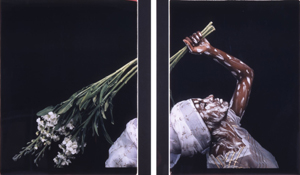1.1.24 — No Time for Heroes
Happy new year! María Magdalena Campos-Pons opens her Brooklyn retrospective with her largest and most layered work yet, in a room to itself just outside. You may have come to expect a museum celebration of craft, culture, and shared memories, including the memories of black women. And Campos-Pons delivers, or does she?
I had never so much as heard of her, but the installation felt instantly familiar. Ironing boards lean against the wall, bearing vintage photos of what must surely be her ancestors—or those of someone very much like her. Videos separate them, with the same size and shape apart from rounded tops, like church windows or altarpieces. Their images come and go, but a woman folding the wash easily rules them all.  She, too, could be an ancestor and a model, but then the installation is, after all, Spoken Softly with Mama. A woman must speak softly but carry a big load and it may not go easy, and I work this together with a recent report on Dineo Seshee Bopape as a longer review and my latest upload.
She, too, could be an ancestor and a model, but then the installation is, after all, Spoken Softly with Mama. A woman must speak softly but carry a big load and it may not go easy, and I work this together with a recent report on Dineo Seshee Bopape as a longer review and my latest upload.
The woman’s irons and hand-held mirrors multiply in front of her, dozens of them, in white glass on the floor. From their shape and direction, they might be ships carrying her to freedom or, radiating outward at the fleet’s center, a star. This could be a heroic saga indeed, except for one thing: it belongs to a series of work, “History of a People Who Were Not Heroes,” from 1998. Museum-goers have become accustomed to a recovery of diversity as a perpetual celebration. Sometimes, though, everyday heroes have to give way to the sadness of the everyday, at the Brooklyn Museum through January 14.
I should have seen the other side of Campos-Pons from the start. Laundry could stand for a due appreciation of women’s work—or horror at a woman’s forced labor. Bare legs also appear on video, leaving in question to whom they belong. Hands holding flowers could just as well be tearing them apart. That fleet recalls the Spanish armadas accompanying the slave trade. As one last turn, the work looks joyful all the same.
Wall text can be resolutely upbeat, and so can the imagery. Its most common motifs are faces and flowers, often covered with or in the shape of eyes. While not often given to humor, the Afro-Cuban artist recasts an Alexander Calder mobile with glass butterfly eyes in red. She also speaks of her spiritual debt to Santería, a blend of African religion and Catholicism. Born in 1959, she left Cuba more than thirty years ago, for Boston and then Tennessee, with studio time in a converted factory in Italy. She has not left her past behind, and footprints in gold and on video record her recent Cuba walks.
Still, there are complications. A “sacred bath” starts in cocktail glasses before oozing onto skin (to the accompaniment of tinkling sounds from Neil Leonard). She wipes it up with leaves as best she can before they decay. The sheer density of what I took for a family album alludes to the packing of bodies on slave ships. Coarse and colorful threads are her Freedom Trap, and other photos show bird cages. Do not expect to learn why the caged bird sings.
Not that this is downbeat art. Titles speak of The Calling, Replenishing, I Am a Fountain, and Classic Creole. Paired photos show Campos-Pons beside her mother, connected by only a thread, but a colorful one. It may suggest an umbilical cord. The exhibition title itself points both ways. “Behold” demands attention, but leaves open a degree of wonder at what one sees.
Campos-Pons sticks to her motifs, in line with the show’s abandonment of chronology but too much for its arrangement by theme, and images can fall well short of wonder. Still, this view of Caribbean art and diversity knows domesticity and pain. Red letters cross a bare chest as if seared into flesh: Identity Could Be a Tragedy. It might not hurt to claim a bit less for high-minded ideals. Heroes have a way of turning out to be arrogant males anyway.
Read more, now in a feature-length article on this site.